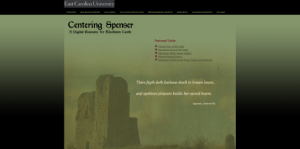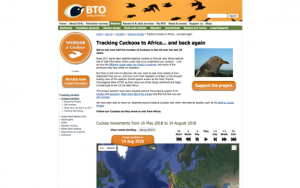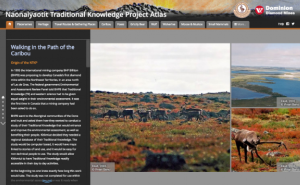Research and Education
Back to Top
|
 |
|
Immigration Since 1840
|
Social studies |
|
For researchers, instructors, and others interested in the history of U.S. immigration, the Digital Public Library of America offers this rich collection of digitized resources (including photographs, documents, letters, newspaper clippings, and much more) related to the topic. This collection was curated by Andrea Ledesma and includes dozens of items from heritage and memory institutions, including the University of Minnesota's Immigration History Research Center, the National Museum of American History, the New York Public Library, the Los Angeles Public Library, and many others. Visitors can browse these items by eight thematic categories. For instance, in the Coming to America section, visitors will find a number of items that document immigrants' experiences and obstacles upon arrival to the US. These items include a 1847 book by Fredrich Pauer that "[describes] Texas and the United States for people interested in emigrating from Germany" and an oral history interview with Mustafa Jumale, who, along with his family, immigrated to the U.S. as a small child in the early 1990s due to civil war in Somalia. Other categories include Becoming an American, Discrimination and Reform, and Immigration Since 1965. [MMB] |
|





|
|
 |
|
FBTEE: The French Book Trade in Enlightenment Europe
|
Social studies |
|
Bibliophiles and scholars of cultural history may be interested in The French Book Trade in Enlightenment Europe (FBTEE), an innovative digital humanities project that uses quantitative methods to study eighteenth-century culture by "track[ing] the movement of around 400,000 copies of 4,000 books across Europe" from 1769 to 1794. In particular, FBTEE focuses on the Societe Typographique de Neuchatel, a Swiss publishing house that many scholars regard as being representative of the late-Enlightenment book trade due to their book sales from numerous publishers (along with their own publications) to clients throughout Europe. It is designed to be a user-friendly resource for scholars and students, and visitors will find a wealth of information, including suggested uses and tutorials for its database, as well as a link to the project's blog for a behind-the-scenes perspective. FBTEE began in 2004 under the direction of Simon Burrows, Professor of History at Western Sydney University (Australia). The project was named the Best Digital Resource for 2017 by the British Society for Eighteenth-Century Studies and as of this writing, it has produced two books and multiple academic articles. [JDC] |
|





|
|
 |
|
 |
|
Centering Spenser: A Digital Resource for Kilcolman Castle
|
Language Arts |
|
For fans and scholars of Edmund Spenser, Centering Spenser: A Digital Resource for Kilcolman Castle has much to offer. This project presents an analysis and reconstruction of the poet's life and experiences at Kilcolman Castle, the now-ruined estate in Ireland where Spenser is believed to have written large parts of his masterpiece The Faerie Queene. One of the many features visitors to Centering Spenser will find is a 3D digital recreation of the Kilcolman Castle complex, which includes interactive and virtual tours, detailed contextual descriptions of objects and structures in the estate, and cross-sectional diagrams of the castle's layout. These reconstructions are based on archaeological evidence as well as the extant ruins and they are accompanied by textual explanations intended to "suggest ways that knowledge of Spenser's material world might help inform our understanding of his creative work." Centering Spenser also includes a timeline of Spenser's life, essays on the historical context of Spenser's activities in Ireland, sample teaching assignments based on two of Spenser's sonnets, multiple bibliographies, and links to many other resources. Centering Spenser launched in 2014 and was directed and written by Thomas Herron, Professor of English at East Carolina University. [JDC] |
|





|
|
 |
|
 |
|
MoneySmart: Teaching resources
|
Social studies |
|
Financial literacy is an important topic that many feel is not given enough attention. To help combat this, the Australian government has produced MoneySmart: Teaching Resources. Here, readers will find a plethora of free lesson plans, digital activities, and other educational resources created for teachers, parents, children, and young adults. These resources can be browsed by year level, by learning area (e.g. science, the arts, digital technologies, etc.), or by focus (e.g. budgeting, young adults, sustainability, etc.). While all of these resources are designed to correspond to the Australian Curriculum, many of their underlying principles and concepts can also be helpful to learners outside of Australia. MoneySmart is run by the Australian Securities and Investments Commission (an independent government body). In addition to its teaching resources, the entire website offers useful consumer and financial literacy information for audiences of all ages. [JDC] |
|





|
|
 |
|
Historical Collections of the Great Lakes
|
Social studies |
|
North America's Great Lakes region has been an important shipping and transportation route for centuries. With the archival resource Historical Collections of the Great Lakes (HCGL), Bowling Green State University Libraries provides access to a number of primary source documents relating to the Great Lakes. Here, interested readers will find databases for Great Lakes vessels, ports, and people, all of which can be searched and browsed to yield a wide range of historical information dating from as early as the eighteenth century up through our current decade. For example, by selecting Cleveland in the ports database, nearly 150 online images of vessels, shipyards, lighthouses, and other structures in and near that port are displayed. Searching the vessels database for the Eastland (of Chicago's infamous Eastland disaster) brings up the ship's official registry number, physical measurements, vessel history, and a photograph. While the HGCL's eye-poppingly orange design may initially be somewhat off-putting, its content makes up for the resource's aesthetics and those interested in Great Lakes maritime history should pay it a visit. [JDC] |
|





|
|
 |
|
A Liberian Journey
|
Social studies |
|
For 64 years, one of the world's largest rubber plantations was operated in Liberia by the Firestone Tire & Rubber Company. In 1926, just after Firestone had gained permission for their plantation, the company sent a team of Harvard scientists and medical doctors on a four-month survey of the West African country's interior. A Liberian Journey is a public history resource intended to "inform, raise questions, and elicit stories about [this] transformational moment in Liberia's past." Visitors to A Liberian Journey will find a fascinating collection of photos, archival film footage, diaries, and letters documenting the survey team's experiences. This resource also features oral histories, an interactive map, and a digital exhibit focused on Chief Suah Koko, the Liberian woman who held a prominent leadership role during the Firestone survey (a rarity for her time). Led collaboratively between the Liberian Center for National Documents and Records Agency and Gregg Mitman, Professor of History of Science, Medical History, and Environmental Studies at the University of Wisconsin-Madison (with contributions from several other institutions), A Liberian Journey is a valuable resource that will appeal to anyone interested in West African colonial history. [JDC] |
|





|
|



















